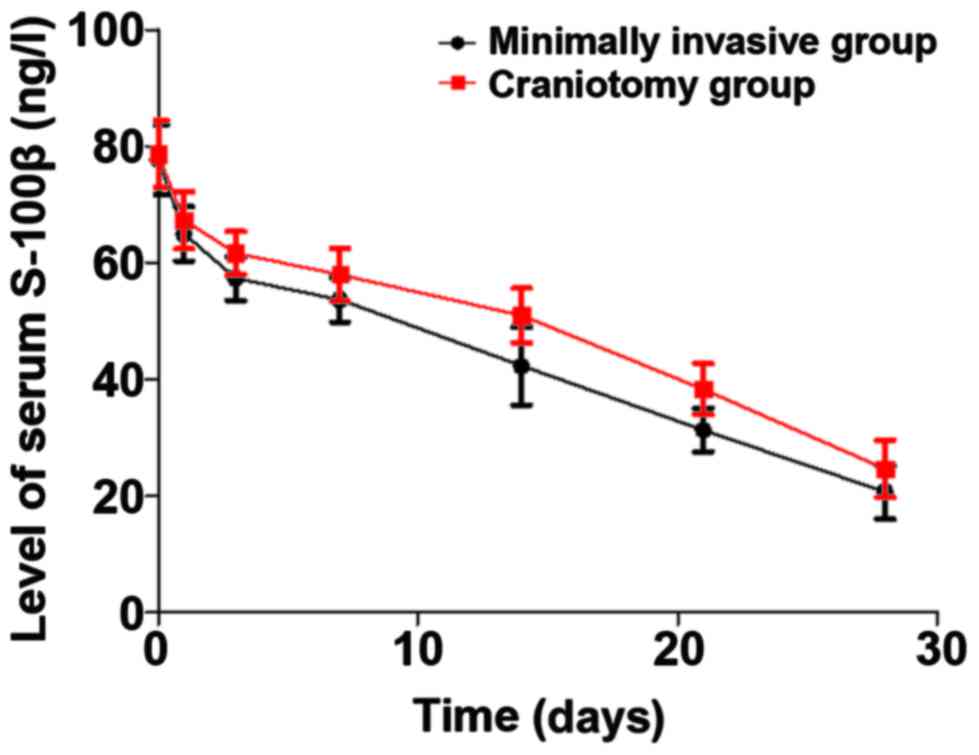|
1
|
Chen G, Ping L, Zhou S, Liu W, Liu L,
Zhang D, Li Z, Tian Y and Chen Z: Early prediction of death in
acute hypertensive intracerebral hemorrhage. Exp Ther Med.
11:83–88. 2016. View Article : Google Scholar : PubMed/NCBI
|
|
2
|
Doden T, Sato H, Sasahara E, Murata T,
Yako T, Kitazawa K, Higuchi K, Kobayashi S and Hashimoto T:
Clinico-radiological characteristics and pathological diagnosis of
cerebral amyloid angiopathy-related intracerebral hemorrhage. J
Stroke Cerebrovasc Dis. 25:1736–1745. 2016. View Article : Google Scholar : PubMed/NCBI
|
|
3
|
Fouda AY, Artham S, El-Remessy AB and
Fagan SC: Renin-angiotensin system as a potential therapeutic
target in stroke and retinopathy: Experimental and clinical
evidence. Clin Sci (Lond). 130:221–238. 2016. View Article : Google Scholar : PubMed/NCBI
|
|
4
|
Hu R and Feng H: Lenticulostriate artery
and lenticulostriate-artery neural complex: New concept for
intracerebral hemorrhage. Curr Pharm Des. 23:2206–2211. 2017.
View Article : Google Scholar : PubMed/NCBI
|
|
5
|
Matsumoto K, Sakaki S, Abekura M and
Yoshimine T: Co-existence of unruptured cerebral aneurysms in
patients with hypertensive intracerebral hemorrhage. Acta Neurochir
(Wien). 146:1085–1089; discussion 1089. 2004. View Article : Google Scholar : PubMed/NCBI
|
|
6
|
Tian X, Shu H, Zhang H, Wang H and Guo L:
Intracranial hemorrhage due to rupture of an anterior communicating
artery aneurysm in a patient with pituitary adenoma. J Craniofac
Surg. 26:e154–e155. 2015. View Article : Google Scholar : PubMed/NCBI
|
|
7
|
Yiannakopoulos CK: Carpal ligament
decompression under local anaesthesia: The effect of lidocaine
warming and alkalinisation on infiltration pain. J Hand Surg Br.
29:32–34. 2004. View Article : Google Scholar : PubMed/NCBI
|
|
8
|
Zhang Y, Liu B, Liu Z, Wang Y, Zhao H, Zi
M, Wang L, Liu H, Chen Z and Xie Y: Development of a
disease-specific health-related quality of life questionnaire for
patients with post-stroke spasticity. J Tradit Chin Med.
32:674–678. 2012. View Article : Google Scholar : PubMed/NCBI
|
|
9
|
Lue YJ, Lin RF, Chen SS and Lu YM:
Measurement of the functional status of patients with different
types of muscular dystrophy. Kaohsiung J Med Sci. 25:325–333. 2009.
View Article : Google Scholar : PubMed/NCBI
|
|
10
|
Kenning TJ, Dalfino JC, German JW, Drazin
D and Adamo MA: Analysis of the subdural evacuating port system for
the treatment of subacute and chronic subdural hematomas. J
Neurosurg. 113:1004–1010. 2010. View Article : Google Scholar : PubMed/NCBI
|
|
11
|
Southwell DG, Hervey-Jumper SL, Perry DW
and Berger MS: Intraoperative mapping during repeat awake
craniotomy reveals the functional plasticity of adult cortex. J
Neurosurg. 124:1460–1469. 2016. View Article : Google Scholar : PubMed/NCBI
|
|
12
|
Velnar T and Bunc G: Iatrogenic metastasis
of a benign meningioma to the periosteum at the site of previous
craniotomy: A case report. Wien Klin Wochenschr. 120:766–769. 2008.
View Article : Google Scholar : PubMed/NCBI
|
|
13
|
Chi FL, Lang TC, Sun SJ, Tang XJ, Xu SY,
Zheng HB and Zhao HS: Relationship between different surgical
methods, hemorrhage position, hemorrhage volume, surgical timing,
and treatment outcome of hypertensive intracerebral hemorrhage.
World J Emerg Med. 5:203–208. 2014. View Article : Google Scholar : PubMed/NCBI
|
|
14
|
Morotti A, Paciaroni M, Zini A,
Silvestrelli G, Del Zotto E, Caso V, Dell'Acqua ML, Simone AM,
Lanari A, Costa P, et al: Risk profile of symptomatic lacunar
stroke versus nonlobar intracerebral hemorrhage. Stroke.
47:2141–2143. 2016. View Article : Google Scholar : PubMed/NCBI
|
|
15
|
Han WY, Tao YQ, Xu F, Zhang YQ, Li ZY and
Liang GB: The short- and long-term efficacy analysis of
stereotactic surgery combined external ventricular drainage in the
treatment of the secondary intraventricular hemorrhage. Brain
Behav. 7:e008642017. View
Article : Google Scholar : PubMed/NCBI
|
|
16
|
Guldberg-Kjär T and Johansson B: ADHD
symptoms across the lifespan: A comparison of symptoms captured by
the Wender and Barkley Scales and DSM-IV criteria in a
population-based Swedish sample aged 65 to 80. J Atten Disord.
19:390–404. 2015. View Article : Google Scholar : PubMed/NCBI
|
|
17
|
Sonni S, Lioutas VA and Selim MH: New
avenues for treatment of intracranial hemorrhage. Curr Treat
Options Cardiovasc Med. 16:2772014. View Article : Google Scholar : PubMed/NCBI
|
|
18
|
Wang WZ, Jiang B, Liu HM, Li D, Lu CZ,
Zhao YD and Sander JW: Minimally invasive craniopuncture therapy
vs. conservative treatment for spontaneous intracerebral
hemorrhage: Results from a randomized clinical trial in China. Int
J Stroke. 4:11–16. 2009. View Article : Google Scholar : PubMed/NCBI
|
|
19
|
James ML, Blessing R, Phillips-Bute BG,
Bennett E and Laskowitz DT: S100B and brain natriuretic peptide
predict functional neurological outcome after intracerebral
haemorrhage. Biomarkers. 14:388–394. 2009. View Article : Google Scholar : PubMed/NCBI
|
|
20
|
Ikedo T, Nakamura K, Sano N, Nagata M,
Okada Y, Terakawa Y and Murata T: Intraoperative transcranial
motor-evoked potentials predict motor function outcome in
intracerebral hemorrhage surgery. World Neurosurg. 90:518–523.
2016. View Article : Google Scholar : PubMed/NCBI
|
|
21
|
Voulgaris S, Karagiorgiadis D, Alexiou GA,
Mihos E, Zigouris A, Fotakopoulos G, Drosos D and Pahaturidis D:
Continuous intraoperative electromyographic and transcranial motor
evoked potential recordings in spinal stenosis surgery. J Clin
Neurosci. 17:274–276. 2010. View Article : Google Scholar : PubMed/NCBI
|
|
22
|
Bestmann S and Krakauer JW: The uses and
interpretations of the motor-evoked potential for understanding
behaviour. Exp Brain Res. 233:679–689. 2015. View Article : Google Scholar : PubMed/NCBI
|










